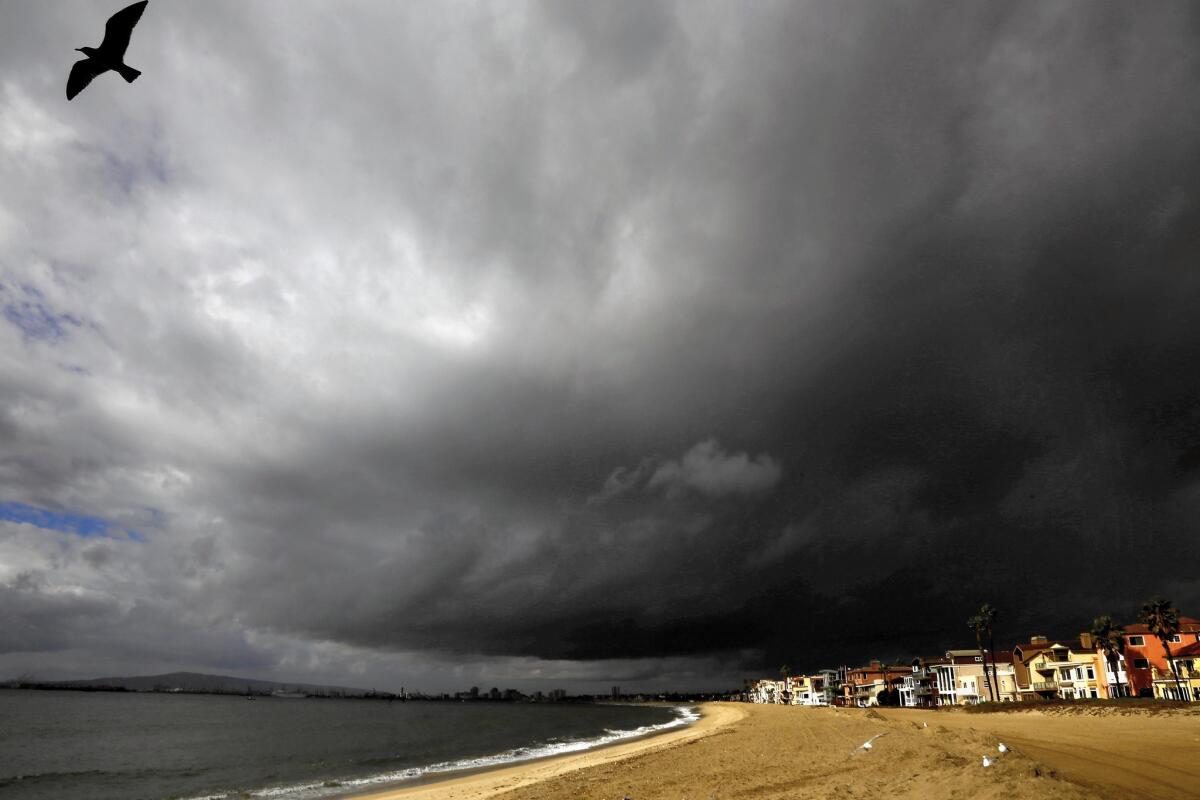Light but steady rain falls in Southland, and a bigger storm is coming

- Share via
Mostly light but steady showers fell across a large swath of Southern California on Sunday, with the heaviest rain falling in mountain and coastal areas, causing mud and rock slides that forced the closure of a section of Pacific Coast Highway.
The stretch of PCH between Yerba Buena and Las Posas roads in southern Ventura County was shut down about 2:30 p.m., stranding some motorists and causing holiday weekend traffic tie-ups along the roadway, officials said. No injuries were reported, and officials said the highway might not reopen until Tuesday.
The Santa Monica Mountains area around the highway closure recorded the heaviest rain for the day, slightly over an inch, according to the National Weather Service. Most other areas in the region received half an inch of rain, while downtown Los Angeles recorded a mere 0.02 inches, leaving it with 0.50 for the rainfall season that began in July. In a normal year, the total would be 1.99 inches.
Periodic bursts of heavy rain in some areas, particularly in the San Fernando Valley, were unexpected.
“Especially in L.A. County, they were looking for lighter amounts, but there was just enough instability in the system to be surprised,” said Stuart Seto, a weather specialist with the National Weather Service. “That’s causing some problems and some ponding in the streets.”
The rain came on the same day that a Pacific storm walloped Northern California, where a number of flights had to be delayed or canceled at San Francisco International Airport because of low clouds and windy conditions, while heavy snowfall blanketed the Lake Tahoe area.
That storm is expected to hit the Southland with full force Tuesday, when as much as five inches of rain in the mountain areas and 1 to 2 inches in downtown Los Angeles are predicted. Scattered showers and cooler temperatures are expected to continue through Thursday. Residents in burn areas in Glendora and Azusa have been warned about possible flooding and mudslides.
“This is going to be a big event for us,” Seto said, comparing the upcoming rains to the drenching that Angelenos got on Halloween. Those rains measured about an inch, Seto said.
The storm is not expected to put much of a dent in California’s persistent drought, however.
“The drought that we’ve had has been in effect for three years,” said David Sweet, a meteorologist with the National Weather Service. “We don’t expect any one storm is going to be capable of making a change.”
Still, recent rain and cold weather have eased the wildfire dangers enough that state officials will officially declare the end of the fire season Monday for three Northern California counties.
Napa, Sonoma and Lake counties have a reduced risk of suffering a fast-moving wildfire and will exit the fire season. The fire season ended in Mendocino, Humboldt, Del Norte, Lassen and Modoc countieslast week, CalFire spokesman Daniel Berlant said.
“Because of the rain, fires are unlikely to become gigantic, huge wildfires,” Berlant said.
The designation changes little for CalFire or residents as a whole, Berlant said. Instead, the change influences mandatory precautions that agencies, such as a utility company, have to take when working in or around vegetation, Berlant said.
Though the weather has provided some relief for Northern California, the southern half of the state hasn’t been as fortunate.
“The fire season in Southern California never ended,” Berlant said. “Unless we get a substantial amount of rain in December, it’s unlikely that Southern California will transition out of fire season this year.”
So far in 2014, CalFire crews have fought more than 5,500 wildfires, about 1,000 more than normal.
Times staff writer Garrett Therolf contributed to this report.
More to Read
Sign up for Essential California
The most important California stories and recommendations in your inbox every morning.
You may occasionally receive promotional content from the Los Angeles Times.












